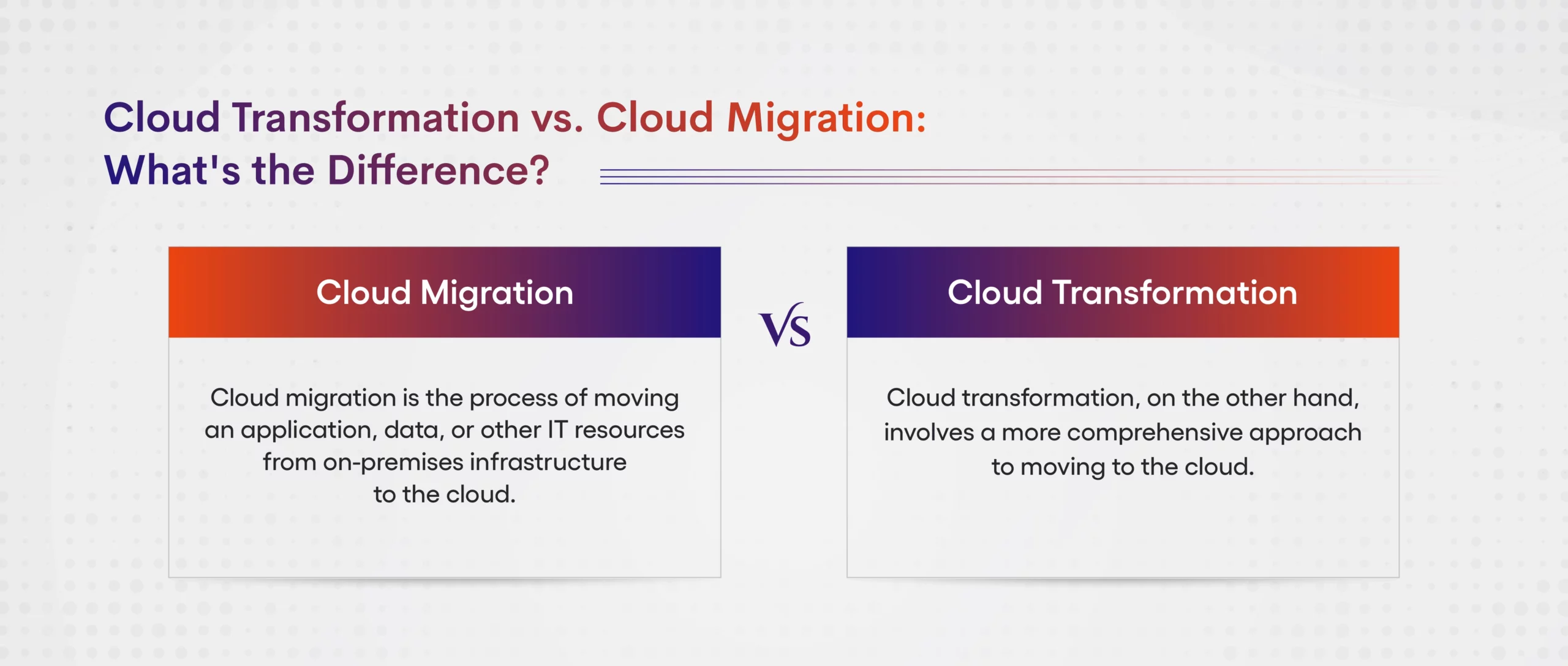- Blog
- May 16, 2023
Cloud Transformation vs. Cloud Migration: What’s the Difference?

- Blog
- May 16, 2023
Cloud Transformation vs. Cloud Migration: What’s the Difference?
Cloud technology has revolutionized the way businesses operate with cost-effective, scalable, and flexible infrastructure. Moving to the cloud is not a simple task, and businesses need to decide between two main approaches: cloud transformation and cloud migration.
This blog article details the key differences between Cloud migration and cloud transformation.

Cloud Migration
Cloud migration is the process of moving an application, data, or other IT resources from on-premises infrastructure to the cloud. This process usually involves replicating existing resources to a cloud environment, which can be public, private, or hybrid. Cloud migration is often used as a way to modernize legacy systems or reduce costs associated with maintaining on-premises infrastructure.
The primary goal of cloud migration is to move existing systems and applications to the cloud with minimal changes to the underlying architecture. The primary benefit of cloud migration is the ability to take advantage of the benefits of cloud computing, including scalability, elasticity, and cost savings. Cloud migration is also typically less complex and less risky than cloud transformation, making it a good option for organizations with limited resources.
Cloud Transformation
Cloud transformation, on the other hand, involves a more comprehensive approach to moving to the cloud. It’s not just about moving applications and data to the cloud; it’s about fundamentally rethinking how IT is done in the organization. Cloud transformation is a holistic approach that looks at the entire IT landscape, including infrastructure, applications, data, and operations.
The primary goal of cloud transformation is to create a cloud-native IT environment that takes advantage of the unique features of cloud computing. This includes designing and building applications that are optimized for the cloud, using cloud-native services to improve performance, and automating operations to take advantage of the cloud’s scalability.
Cloud transformation is typically more complex and involves more risk than cloud migration. However, the benefits of cloud transformation are also greater. By creating a cloud-native IT environment, organizations can take full advantage of the benefits of cloud computing, including faster time-to-market, improved scalability, and greater flexibility.
Which Approach Should You Choose?
Deciding between cloud transformation and cloud migration depends on your organization’s goals, resources, and IT landscape. If you’re looking to move existing systems and applications to the cloud with minimal disruption, cloud migration may be the best option. If you’re looking to create a cloud-native IT environment and take full advantage of the benefits of cloud computing, cloud transformation may be the way to go.
It’s important to remember that both approaches are not mutually exclusive. Organizations can start with cloud migration and then gradually move towards cloud transformation as their needs evolve. Alternatively, organizations can focus on cloud transformation for new applications and gradually move existing applications to the cloud through a more gradual migration process.
In Conclusion
Cloud transformation and cloud migration are two different approaches to moving to the cloud. Cloud migration involves moving existing systems and applications to the cloud with minimal disruption, while cloud transformation involves fundamentally rethinking how IT is done in the organization to take full advantage of the benefits of cloud computing. Deciding between these two approaches depends on your organization’s goals, resources, and IT landscape.




